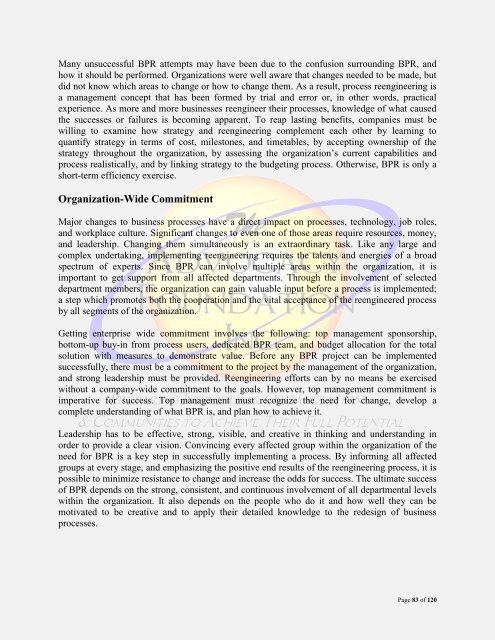Organizational Development - Vol. V, Part II
Organizational Development - Vol. V, Part II
Organizational Development - Vol. V, Part II
You also want an ePaper? Increase the reach of your titles
YUMPU automatically turns print PDFs into web optimized ePapers that Google loves.
Many unsuccessful BPR attempts may have been due to the confusion surrounding BPR, and<br />
how it should be performed. Organizations were well aware that changes needed to be made, but<br />
did not know which areas to change or how to change them. As a result, process reengineering is<br />
a management concept that has been formed by trial and error or, in other words, practical<br />
experience. As more and more businesses reengineer their processes, knowledge of what caused<br />
the successes or failures is becoming apparent. To reap lasting benefits, companies must be<br />
willing to examine how strategy and reengineering complement each other by learning to<br />
quantify strategy in terms of cost, milestones, and timetables, by accepting ownership of the<br />
strategy throughout the organization, by assessing the organization‘s current capabilities and<br />
process realistically, and by linking strategy to the budgeting process. Otherwise, BPR is only a<br />
short-term efficiency exercise.<br />
Organization-Wide Commitment<br />
Major changes to business processes have a direct impact on processes, technology, job roles,<br />
and workplace culture. Significant changes to even one of those areas require resources, money,<br />
and leadership. Changing them simultaneously is an extraordinary task. Like any large and<br />
complex undertaking, implementing reengineering requires the talents and energies of a broad<br />
spectrum of experts. Since BPR can involve multiple areas within the organization, it is<br />
important to get support from all affected departments. Through the involvement of selected<br />
department members, the organization can gain valuable input before a process is implemented;<br />
a step which promotes both the cooperation and the vital acceptance of the reengineered process<br />
by all segments of the organization.<br />
Getting enterprise wide commitment involves the following: top management sponsorship,<br />
bottom-up buy-in from process users, dedicated BPR team, and budget allocation for the total<br />
solution with measures to demonstrate value. Before any BPR project can be implemented<br />
successfully, there must be a commitment to the project by the management of the organization,<br />
and strong leadership must be provided. Reengineering efforts can by no means be exercised<br />
without a company-wide commitment to the goals. However, top management commitment is<br />
imperative for success. Top management must recognize the need for change, develop a<br />
complete understanding of what BPR is, and plan how to achieve it.<br />
Leadership has to be effective, strong, visible, and creative in thinking and understanding in<br />
order to provide a clear vision. Convincing every affected group within the organization of the<br />
need for BPR is a key step in successfully implementing a process. By informing all affected<br />
groups at every stage, and emphasizing the positive end results of the reengineering process, it is<br />
possible to minimize resistance to change and increase the odds for success. The ultimate success<br />
of BPR depends on the strong, consistent, and continuous involvement of all departmental levels<br />
within the organization. It also depends on the people who do it and how well they can be<br />
motivated to be creative and to apply their detailed knowledge to the redesign of business<br />
processes.<br />
Page 83 of 120

















